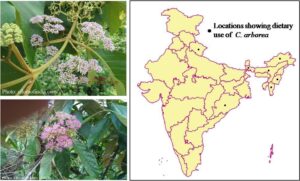Popular as Red silk cotton tree or Semal, Bombax is synonymous with Indian summer when its bright red flowers are popped out of leafless branches extravagantly. The culinary use is widely reported from the states like Arunachal Pradesh, Assam to the western state of Gujarat, and northern Uttarakhand to southern Kerala. The flower is the most ubiquitously used ingredient in all the preparations, less are roots and leaves. Only the spices and the mode of preparations vary with geography. The popular recipe of Semal Sabji requires tender flower accompanied by potato, tomato, onion, and spices like ginger, turmeric, chili, methi, etc. It starts with the separate frying of the green sepals (from the flower) and potato in mustard oil. A spicy and aromatic paste is prepared with onion, tomato, ginger, garlic and other spices separately and is mixed with fried sepals and potato. Finally, after adding water, the mixture is cooked for a few minutes, and then Voila, the final form. Likewise in Uttarakhand, a sabji from the young flower bud (Simbal) is prepared as a seasonal delicacy. In Rajasthan, the young roots of the plant is roasted and eaten after peeling off the skin. Even, the young roots are cut into pieces, mixed with spices, and boiled ..and your yummy hot dish is ready. The young leaves are boiled with condiments are consumed as vegetables in Kerala (Poola) and Rajasthan. Nutrition-wise, 100 gms of fresh flower buds mean a nutrition package of protein (1.4gm), carbohydrate (11.9 gm) and minerals like calcium, phosphorus and magnesium.




